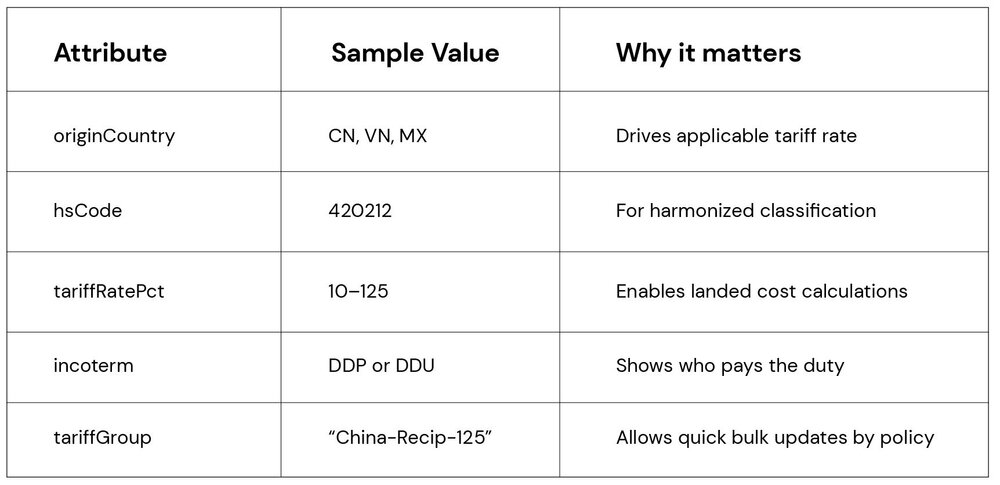The Hidden Fix for Tariff Chaos
How simple changes in the way you price, tag, and fulfill inventory can prevent major margin erosion.
The world is in an on-again-off-again relationship with US tariffs. With nearly all imports facing baseline duties of 10% and some goods climbing as high as 125%, they’re hitting in places few retailers expected and they’re hitting hard. For brands that rely on global sourcing, it’s not just a cost issue; it’s a visibility issue. Most teams can’t even tell which SKUs are impacted until margins are already underwater.
What’s worse: the effects ripple out far beyond finance. Promotions built on pre-tariff costs are suddenly unprofitable. Inventory velocity slows. Order routing logic—designed for speed, not cost—starts bleeding dollars with every decision. And when leadership asks for answers, they get dashboards that don’t include duty exposure at all.
But here’s the upside: you don’t need a major systems rebuild to start protecting your margins. If your business already runs a modern OMS (order management system) alongside a WMS (warehouse management system), a few focused adjustments—like tagging SKUs by source, exposing landed costs early, and adjusting fulfillment logic—can quickly improve profitability across teams. Even your checkout strategy becomes a lever, letting you decide when to absorb duties and when to pass them through without damaging CX.
When it comes to tariffs, the best defense isn’t complicated. It’s composable.
Why Tariffs Suddenly Matter (Again)
The U.S. government’s latest round of trade measures has introduced a new baseline 10% tariff on all imports. For high-volume categories like apparel, footwear, and electronics—many of which are still sourced heavily from Asia—tariffs can spike up to 125%. And with the de minimis exemption removed for China-origin parcels, even DTC parcel shipping is now subject to duty.
These costs don’t just hit your margin, they disrupt the whole supply chain. CFOs can’t predict profitability. Promo teams risk pricing SKUs below cost. Inventory piles up in the wrong distribution centres. And nobody in the business knows where the pain is coming from, because it isn’t visible in the tools they use every day.
Start by Tagging the Truth
One of the simplest but highest-leverage changes you can make is tagging SKUs with key tariff-relevant data. If your OMS supports custom attributes—and most modern ones do—you’re one schema extension away from solving a lot of internal guesswork.
Here’s the minimum you need:

Once tagged, SKU data becomes the basis for smarter decisions across planning, pricing, finance, and fulfillment. If you’re already storing supplier or PO data, you can often populate this with a simple import and a lightweight duty-rate API integration.
Expose Landed Cost to Avoid Bad Decisions
Tagging SKUs is step one. Step two is showing the right people the right data, without waiting on a six-month business intelligence project.
With composable stacks, it’s easy to expose landed costs through embedded dashboards or GraphQL views. And doing so gives your business users the clarity they’ve been missing.
Three views that change the conversation:
- Margin heat-map: Show gross margin after duty and freight by SKU or category
- Duty exposure waterfall: Compare pre- and post-tariff cost impacts across lines
- Promo guardrail: Flag or block promotions where added duties push GM below threshold
When merchandising and finance have a shared view of reality, teams make faster, better decisions, and you stop shipping unprofitable goods just to move them.
Get Strategic with Checkout Duties
One underused lever? Checkout. With tariff rates varying by SKU and order origin, you can adapt your pricing strategy dynamically, either absorbing duties into your margins or showing them as a separate charge at checkout.
Here’s a quick breakdown:

Many brands toggle this behavior by SKU or cart value. The key is to base it on real tariff data, not just gut feel. Even conditional UI (“Includes duties” vs. “May include duties”) can improve clarity and trust without adding friction.
Reroute for Profit, Not Just Speed
Most routing logic prioritizes delivery time or fulfillment cost. But in a tariff-heavy environment, you can improve GM just by sending the order to the right node— even if it’s slightly slower.
For example:
- High-tariff SKUs may be cheaper to fulfill via 3P marketplaces where duties are embedded into pricing
- Promo SKUs may need to ship from a node where goods already cleared customs at a lower bulk-import rate
- Hero SKUs should route based on landed cost, not just proximity
When merchandising and finance have a shared view of reality, teams make faster, better decisions, and you stop shipping unprofitable goods just to move them.
If your OMS supports conditional logic or routing extensions, you can implement rules like:
IF any order.line.tariffRatePct > 25
THEN preferNode = “Marketplace3P”
ELSE
preferNode = “LowestLandedCost”
That one rule could defend thousands in margin per week, without slowing fulfillment.
Small Changes, Big Protection
None of these changes require replatforming. They’re enhancements to systems you already use. With a modern OMS and a flexible data layer, business users can finally see what’s eating margin and act quickly instead of waiting on a finance report or another repricing cycle.
The combination of SKU-level tagging, surfaced landed cost, smarter routing, and selective duty pricing creates real agility. That’s the promise of composable: you don’t have to start over to stay competitive, you just have to work smarter with the stack you’ve got.
Thomas Mulreid
VP, Sales, Orium
Thomas Mulreid, VP Sales at Orium, brings a deep understanding of the headless and composable commerce ecosystem and the future it unlocks for major brand transformation projects. He has been involved in 50+ projects, bringing both the technical and business-centric knowledge required to plan and execute successful composable commerce replatforms.